
The matter era

© 2005 Pearson Prentice Hall, Inc
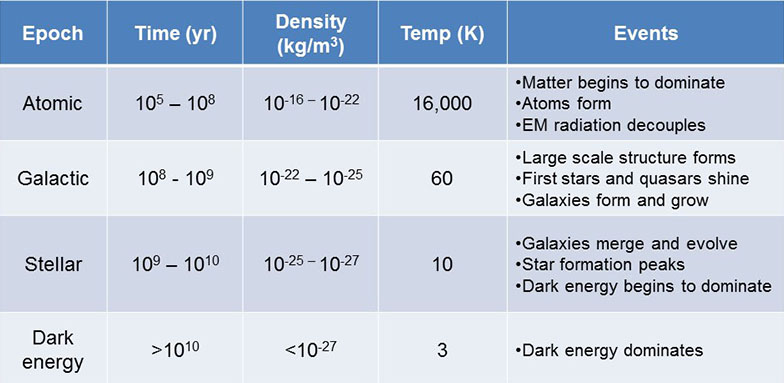
© 2011 Pearson Prentice Hall, Inc
Recombination (decoupling of light)



© 2011 Pearson Prentice Hall, Inc
When the electrons became bound to nuclei, only photons with energies that corresponded to differences between excited electron states could interact with electrons. Other photons were free to flow. When atoms were formed, the universe became transparent to most wavelengths of light. This phenomenon is called recombination, or the decoupling of light from matter.
-
Atomic epoch
- Matter begins to dominate
-
Atoms form
- Temperature drops low enough
for electrons to become
bound to atoms
-
-
EM radiation decouples
- Universe becomes transparent
- Only photons with particular
-
EM radiation decouples
wavelengths interact with
bound electrons
-
- CMBR released
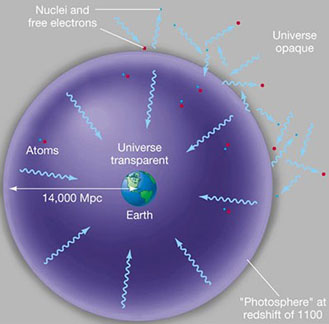
© 2011 Pearson Prentice Hall, Inc
When the universe became transparent to photons, most of the light was free to move. We can calculate the distance that the light has traveled since its release, at somewhat under 14 billion light years, by comparing the peak wavelength that the light would have at the temperature where atoms could form to the redshifted light that we see in the cosmic microwave background radiation.
The horizon problem
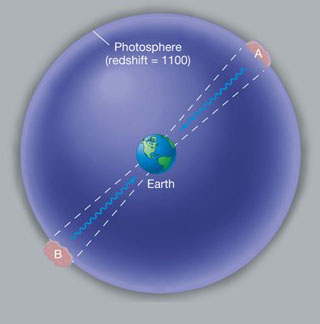
© 2011 Pearson Prentice Hall, Inc
The cosmic microwave background radiation is very uniform across the sky. In every direction, we measure the same temperature, with very tiny fluctuations. The problem is that when the light was released, the universe was already so large that light would not have enough time to traverse the distance to carry the signal from one horizon to the other. In other words, light could not have a causal effect across distant regions.
The regions marked "A" and "B" in the diagram above look practically identical to us, yet they were separated by millions of parsecs when they emitted the light that is reaching us now. It is possible, but unlikely, that the reason these regions look the same now is that they started out with the same characteristics.
Inflation
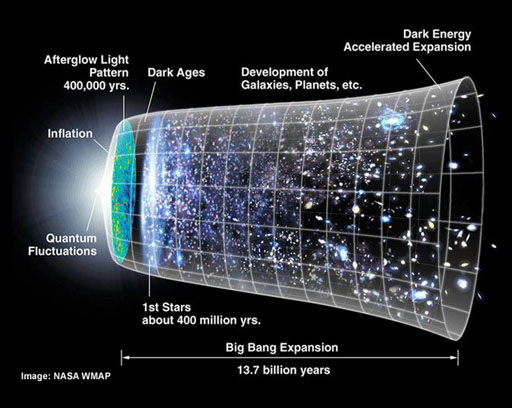
One way of solving the horizon problem is to consider the possibility that they universe went through a short burst of very rapid expansion at the end of the quark era, called "inflation." We believe that the universe underwent something like a phase change when the fundamental forces reorganized as they were being frozen out. It entered a false vacuum state with very high energy, acquiring enormous pressure, resulting in an ultrafast readjustment.
A very rapid expansion of the universe could be seen as analogous to a rapid phase change in normal matter, like what is seen when supercooled water freezes.
We can use the freezing of supercooled water as a way to understand what might have happened during an inflationary period, and what could have caused it.
Very pure water can be cooled to a temperature somewhat below the freezing point without actually freezing until it is perturbed, then it freezes very rapidly. Cosmologists believe that the same thing could have happened in the early universe. It may have been undergoing transitions like phase changes, and delayed the change, staying in a metastable phase for a bit too long, then rapidly dropping into the lower energy state. Some cosmologists think this could have happened several times.
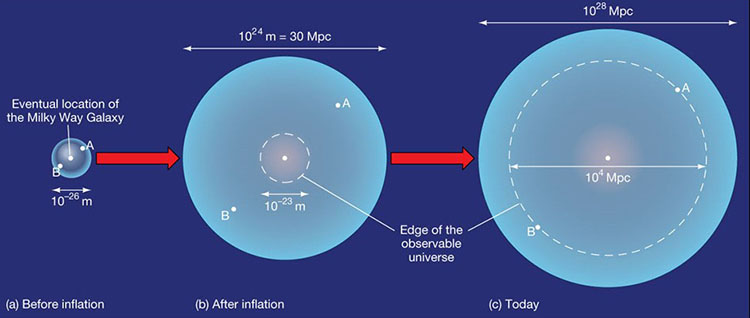
© 2011 Pearson Prentice Hall, Inc
An inflationary period solves the horizon problem by recognizing that the inflation took two points that were causally connected could be rapidly dragged apart if the expansion was faster than the speed of light. The laws of physics say that nothing can travel faster than the speed of light. To be more precise, no signal can travel faster than light speed.
This doesn't mean that the whole universe could not expand faster than light speed, since it is space that is expanding, not a signal propagating across space. In the diagram above, points A and B start out close enough together that they can be causally related - they can affect each other because light can pass between them. After inflation rapidly expands space, A and B are no longer causally connected, but as the universe further expands they are both within sight again. They look similar because they were causally connected before inflation happened.
The flatness problem

© 2011 Pearson Prentice Hall, Inc
Another cosmological issue that inflation addresses is the flatness problem. When we add up all of the normal matter, dark matter and dark energy of the universe, the density of the universe turns out to be extremely close to the critical density of the universe. We appear to have a flat universe. Simply stated, the flatness problem asks, of all possible densities for the universe, why we should happen to have this special value?
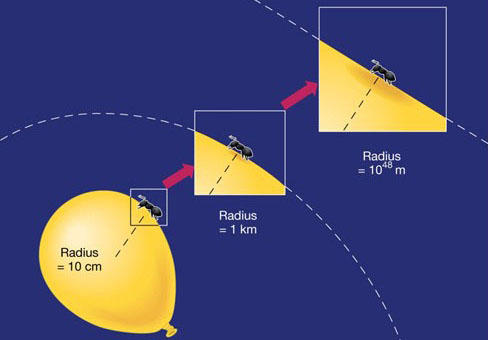
© 2011 Pearson Prentice Hall, Inc
Inflation solves this problem by looking at the whole picture. At early times before inflation, there could have been strong curvature to the universe. After the universe was blown up by inflation, the curvature looks locally flat because we are only seeing a very small part it.

After recombination, the universe entered what we call the "Dark Ages." There would be nor more light produced until fusion took place in the first stars. The galactic epoch was marked by the formation of the large scale structure of the universe.
21-cm radiation refers to the radiation emitted by vast clouds of hydrogen. The electron in a hydrogen atom aligns with the ambient magnetic field. It can also go into an excited state where it has the opposite alignment, then relax back to the lower energy state. When it relaxes, it emits a photon with a 21-cm wavelength. By locating regions of 21-cm emissions, we can identify places that date back to early star formation.
-
Galactic epoch
- Large scale structure forms
-
- First stars and quasars shine
-
- Galaxies form and grow
-
Stellar epoch
- Galaxies merge and evolve
- Star formation peaks
- Dark energy begins to dominate
-
Dark energy epoch
- Dark energy dominates the universe
Cold dark matter and large scale structure
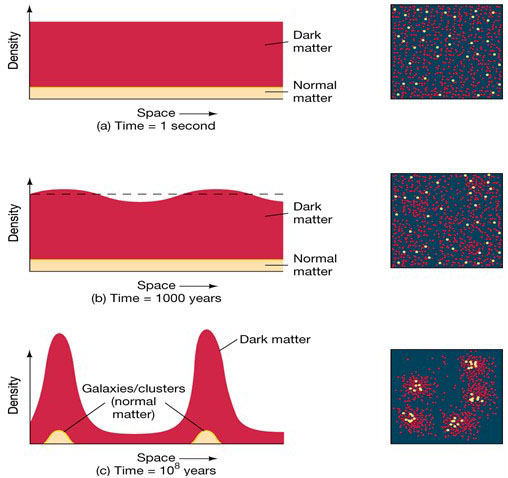
© 2011 Pearson Prentice Hall, Inc
It is believed that cold dark matter played a very important role in the formation of the large scale structure of the universe. Quantum mechanical fluctuations are very similar in character to large scale fluctuations we see today. Matter densities, however, vary much more than the CMBR temperatures. Hot dark matter does not have a tendency to clump, since the particles are moving so fast. Cold dark matter is attracted gravitationally but not repelled electromagnetically, and moves at slow enough speed that it could form clumps early in the history of the universe. It could provide the scaffold for normal matter to gravitationally contract into structures like early galaxies.

© 2005 Pearson Prentice Hall, Inc
Computer simulations show good agreement between structure seen in quantum mechanical fluctuations and large scale structure seen in the universe today.

Image credit NASA/ESA/Massey
Three dimensional mapping of dark matter using gravitational lensing slices indicates that there is good agreement between dark matter haloes and large scale structure involving galaxy clusters.
Analysis of data from NASA's Fermi gamma ray telescope was used to understand the fossil radiation field of light from stars even after they cease to shine. This animation tracks several gamma ray photons along their journey through the universe, encountering optical and UV photons from starlight, ultimately arriving at the Fermi telescope.
Dark energy epoch
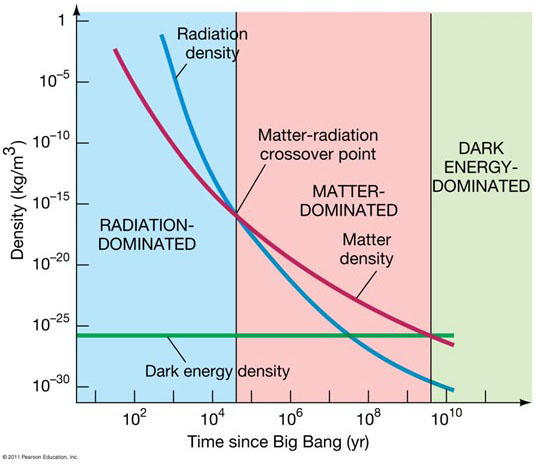
© 2005 Pearson Prentice Hall, Inc
This diagram illustrates the timeline for the radiation, matter and dark energy dominance in the universe. At the present time, we are in the dark energy epoch. The radiation density and matter density both continued to fall as the universe expanded, but dark energy density remained constant. Eventually, dark energy became the dominant material in the universe. This raises some interesting questions.
How can the density of dark energy remain constant?
The size of the universe keeps getting bigger and bigger. Doesn't this mean that there is more and more dark energy? Doesn't that break some kind of conservation law?
It could be that there exists a kind of potential dark energy. It would be similar in concept to gravitational potential energy. When you lift a massive object, say a bowling ball, you do work against gravity to lift it. The higher you lift it, the more work you do. That work energy is stored as potential energy. When you drop the ball, it falls to Earth, moving faster and faster. The gravitational potential energy is converted to kinetic energy of motion. The total energy is conserved; it just changes form from potential to kinetic energy.
Similarly, the dark energy we see could be arising from a potential dark energy. It is not being created from nothing. It is just changing form.
Now, what about the curvature of the universe? We think we have a flat universe, but now we see that the expansion rate of the universe is increasing. Isn't that a contradiction?
How can we say that we have a flat, accelerating universe?
We originally defined curvature as measured by the path that light takes through the universe.Specifically, the CMBR has rippling, or fluctuations in temperature. We see hot spots and cooler spots. We can calculate what the relative sizes of the hot spots should be, based on quantum mechanical fluctuations in the kind of matter and energy field that we think existed early in the universe. If they appear magnified, compared to our theory, it indicates positive curvature (like a magnifying glass). If they appear smaller than our theory predicts, it indicates that the curvature of the universe is negative.
It turns out that the size of the ripples in the CMBR are what we would expect them to be, compared to our simulations of the early universe. This indicates a flat universe.
We can independently calculate the density of normal matter, dark matter and electromagnetic radiation. The density of the combined normal matter, dark matter and electromagnetic radiation gives a value below critical density for the universe. This would indicate a closed universe.
What we see is that the evidence indicates we have an accelerating universe. This evidence comes from the intersection of three observational methods: (1) the rippling of the CMBR, (2) the redshifts of distant galaxies using Hubble’s law and supernovae, and (3) the large scale structure seen in galaxy clusters.
Now we need to add in the density of dark energy. Our evidence indicates that something is pushing galaxies apart on a very large scale, we call it dark energy. We can calculate how much energy that would take. We can find the density by dividing the energy by volume. When we add the density of the dark energy to the density of the other three sources, we end up with a value for density that is extremely close to critical density.
But critical density no longer equates to a critically unbound universe. That is because dark energy does not act like normal matter or dark matter. It adds density without adding gravitational attraction. It appears to add density while also adding something that acts like repulsive gravity, or negative pressure.
This plot illustrates the timeline of the early universe. The matter density falls as the volume of the universe increases. We also see that the temperature is falling, but more slowly than the matter density.
The onset of the nuclear epoch is defined as the time when primordial nucleosynthesis begins. Nucleosysthesis is the creating of nuclei. It may seem odd that the atomic epoch came after the nuclear epoch, but remember that we define atoms as nuclei having bound electrons. The particles that make up atoms were formed in the lepton epoch (electrons) and in the nuclear epoch, but atoms were not formed until the universe further cooled to temperatures where electrons could stay bound to the nuclei.